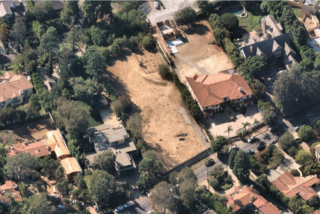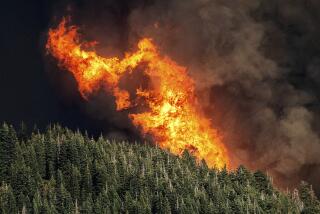Where the Wild Things Are : Remember that childhood spot by the water, under a tree or in a field that held you in awe of the world? Kids today are losing that sense of nature as home.
- Share via
This might sound touchy-feely, but try it anyway: Close your eyes. Think of a pleasant, natural spot where you dawdled as a kid. Cram as much detail into the mental picture as you can: the texture of leaves, the patterns of the shifting light, the scent of the dirt, the prick of thorns, the surrounding sounds--doves, a sump pump, whatever.
Now retrieve the feelings that place inspired.
Adults are often stunned by how quickly and vividly this experiment floods their minds.
But in “The Geography of Childhood” (Beacon Press, 1994), Stephen Trimble and Gary Paul Nabhan worry that today’s children may never build similar reservoirs of sensory imagery.
On the one hand, the authors did find children like Jennifer, a sixth-grader from the little town of Twin Bridges, Mont., who could rhapsodize about a favorite place:
“I like it in the cow pasture . . . in summer you can lay in the grass and stare at the sky. During a rainstorm you can stand and watch the lightning. You feel like you’re part of the storm.”
But they also mention a Los Angeles boy they saw on a PBS special, who could identify half a dozen types of weapons by their sounds.
“In another place and time he would have spoken as matter-of-factly about the calls of six common species of hawks and owls,” they write in this collection of personal essays and reportage.
Trimble and Nabhan have encountered an almost universal reaction at readings of their book. “People are incredibly intent on telling us the story of their magic secret place down the block,” Trimble says.
Then the same people lament that their special place has been radically altered--or obliterated--since they were kids.
The book’s preface lays out the problem: “Simply put, we are concerned about how few children now grow up incorporating plants, animals and places into their sense of home.”
*
Trimble and Nabhan met in 1973 at the Miami airport, in the middle of the night, as they headed to the Galapagos Islands on a field study expedition. Their friendship deepened as each established himself as a respected naturalist and author.
When they became fathers, they began to watch their children with the intensity they’d paid previously to Native Americans and desert plant life. And as they poked around in the rich but unfamiliar turf of child development theory, they discovered that they weren’t alone in noticing that kids seem to get something unique from outdoor settings. As they wrote, their essays quickly filled with the observations of psychologists, naturalists and other observers of nature and childhood.
In his introduction to the book, author and educator Robert Cole recounts his observation of a young Hopi girl: “Her mind seemed almost lost in thought, so engrossed was she with the land and sky, the sun, moon and stars, the flowers her mother grew, the animals, the changes of light that came with the clouds.”
Trimble and Nabhan also cite author William Kittredge, who looks back on similar moments spent in the southeast Oregon ranchland of his youth as “the main staging ground for my imagination.”
In fact, many of the world’s most creative thinkers had similar places, the authors argue, citing evidence from Edith Cobb’s influential book, “The Ecology of Imagination in Childhood.” (Columbia University Press, 1959).
The solitude of nature, Cobb found, often gave a cognitive slap to artists, poets and novelists. It awakened them to the paradoxical realization that they are absolutely separate from other beings and connected to the greater fabric of life.
Rural kids, ranch kids in particular, have a strong link to this reality, the authors discovered.
“Death may move them,” Trimble writes, “but it does not shock them. Their intimacy with animals is an intimacy with life.”
They quote writer and rancher Teresa Jordan, who describes the end of a child’s day during calving season: “We come in each evening splattered with mud and milk and manure, stained with blood and amniotic fluid, stinking of afterbirth. It’s hard to convey the sheer satisfaction of it all.”
*
The education such experience conveys resonates throughout the children’s lives. “A woman who pulls a calf in open country in subzero weather and then wraps the calf in her own coat to keep it alive knows something about fierceness,” Jordan says. “And a man who does the same knows something about nurture.”
Besides evoking strong memories, Trimble and Nabhan find that their book also elicits an urgency in readers to get their kids out, “to take their kids camping.”
But children, the authors say, tend not to experience wilderness the way adults do. The Trimble family, for instance, spent Memorial Day weekend in the remote Toroweap area of Grand Canyon National Park. While the adults marveled obligatorily at the sweeping rock vistas and dazzling sky, the kids were much more focused.
“They were interested in the potholes, where they could play in the mud,” Trimble says. “We had two 6-year-olds, who spent the whole day in a cubbyhole, playing in the rocks.”
Nabhan recalls his efforts to steer his children to the big and impressive animals at the zoo one day.
“They discovered one ground squirrel that kept a cache of food under the sidewalk leading toward the ‘exotic wildlife’ area; we sat down and spent the rest of the afternoon engaged in hide-and-seek with this spermophilous visitor to the zoo. No name tag in Latin, no interpretive message about his role in the ‘chain of life’ was needed for this creature to capture the attention and hearts of my escorts for hours.”
Wild, the authors learned, is not found only in the wide open spaces where romantic adults might seek it.
Environmental psychologists Rachel and Stephen Kaplan call the untamed realm within the city or suburb “nearby nature.” British planner Robin Moore labels it “rough ground.”
Just beyond the reaches of adult scrutiny, children explore it, dig and get dirty in it, build forts and catch lizards in it.
And in the process, they learn skills and gain understanding of the world that people can’t teach. Yet most planners, Moore says, strive to systematically eliminate this unruly element from their grand urban designs.
“Where,” he wonders, “is this vital activity to be carried on if every part of the child’s environment is spoken for to meet the economic, social and cultural needs of the adult community?”
*
On the other hand, proximity to bona fide Big Nature doesn’t guarantee that a kid will become a young John Muir.
More and more often, the authors argue, American imaginations are linked to the land only through television. They cite a 1992 poll showing that 53% of children name the media as their primary source of information about the environment.
Even in rural Arizona, one boy who was asked whether he received most of his nature knowledge from his elders or books, replied: “Neither. The Discovery Channel.”
Naturalist Robert Michael Pyle terms this “the extinction of experience.”
Nabhan and Trimble were careful not to turn “The Geography of Childhood” into a soapbox. They say flat-out that it’s not a guide “to ‘green’ child-raising.”
Which is not to say that they haven’t sprinkled what they see as good ideas throughout the text.
For starters, Nabhan says, adults--especially those who have been insulated from wild places--need to get past their fear of the untamed. Far too many modern kids encounter the great outdoors only in barren asphalt parks with cookie-cut plastic jungle gyms and hyper-structured activity schedules.
“Better to let kids be a hazard to nature and let nature be a hazard to them,” says naturalist Franklin Burroughs. Kids, echoes psychologist Brian Sutton-Smith, need to experience “smells, tastes, splinters and accidents.”
Locally, groups from the Santa Monica Mountains Conservancy to Friends of the Los Angeles River work continuously to preserve just the sort of open space the authors describe.
Speaking at the May dedication of Elyria Canyon Park, near Mount Washington, Supervisor Gloria Molina said that swatch of wild land within sight of Downtown would teach children--including her own 7-year-old daughter--about plants and birds and deer.
But, Molina added, there is another lesson for children in the way community activists battled bureaucrats and cajoled developers to preserve those 35 acres of native walnuts and scrub brush: “They will also learn about tenacity.”
That cycle, a child’s immersion in wild space evolving into protectiveness of wild space, gives the authors hope.
“If you care about those small things in nature--wrens and frogs and a little patch of brush at the edge of a manicured park--it’s going to change your values,” Trimble says. “Gary and I have a lot of trust in the power of the land to work on people.”
As “The Geography of Childhood” puts it: “As parents, our job is to pay attention, to create possibilities--to be careful matchmakers between our children and the Earth.”
More to Read
Sign up for our Book Club newsletter
Get the latest news, events and more from the Los Angeles Times Book Club, and help us get L.A. reading and talking.
You may occasionally receive promotional content from the Los Angeles Times.







